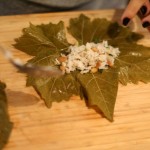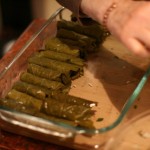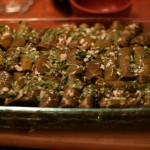If you know not the creamy comfort that is biting into an enormous and aptly-named gigante bean, then it is my mission today to convince you to seek out this elusive packet of leguminous deliciousness.
While many folks profess to like beans, they fail to see what inspires my unbridled passion for these little packets of complex-carbohydrate goodness. After all, the American bean vocabulary tends to be pretty limited: we know garbanzos, kidneys, black beans and cannelinis. Occasionally we dabble in pintos or black-eyed peas. But unless it comes in a can, most of us can’t be bothered to expand our bean horizons.
If ever there was a bean to inspire a nation to abandon its lazybean tendencies, however, surely the Gigante (aka: Gigande, Yigante, Hija) must be it. Most popular in Greek cuisine (yes, the same clever people who brought us geometry and democracy have also retained this most delicious of beans in their collective leguminous repertoire), gigante beans boast a divine creamy texture and the ability to maintain their shape after all sorts of cooking. I decided it was time to start making my own gigantes after the $9.99/lb Antipasto bar at Whole Foods lured me in one time too many with that ridiculously delicious Gigante Bean salad of theirs. (What kind of person spends $18.98 on an impulse bean purchase?!) Like all bean varieties, Gigantes are an excellent source of complex carbohydrate, protein, fiber, antioxidants and a good source of iron.
Buying Beans
My new favorite place to buy beans is Purcell Mountain Farms, an Idaho-based farm with an excellent online store. In addition to having the most reasonable prices for my favorite hard-to-find Gigante beans and Beluga lentils, they offer a surprising variety of organic and heirloom bean varieties with romantic names and fashionable appearances.
If you are a bean buff and are interested in learning more about the folklore behind the wide, wonderful world of beans–as well as how to prepare them–I strongly recommend Aliza Green’s essential cookbook, Beans, from which I learned, for example, that Gigante beans are a variety of so-called “runner beans” that were brought to America from Greece and Spain.
Cooking beans from scratch
While I resisted it for years, I have come to discover that cooking beans from dry isn’t nearly as annoying as I had thought it would be. If you have the foresight to plan ahead, tomorrow night’s dinner beans into a big bowl of water in a ratio of about 3 cups water per 1 cup beans before you go to bed is the easiest way to prep your beans for a faster cooking time the next day. And if you’re as Type A as I am, the feeling of accomplishment that comes with multi-tasking overnight will lull you into a happy, albeit geeky, slumber. This would be the regular soaking method.
The quick-soaking method takes about an hour to an hour and a half. In this case, you’d put your beans in a large saucepan so that they’re covered with 2 inches of water. Bring the water to a boil and simmer for 2 minutes. Then, turn off the heat, cover the pan, and let your beans soak in the water for 60-90 minutes, until tender. Drain the water and proceed with your recipe.
The #1 rule when cooking any dry bean is to avoid adding acid of any kind with the bean until it is already tender. Don’t add any vinegar, wine, citrus juice, tomato product or anything else acidic to the cooking water until your beans are nice and soft; otherwise, the acid will prevent your beans from softening no matter how long you cook them.
Gigante Beans: Two Ways




































